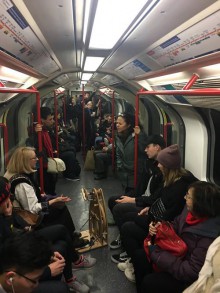Born and raised in the Vinnytsia region and living in Britain for many years, Olena staged an “ethno-provocation” in the London Underground. “It was more of an experiment or a check to see the reaction of people,” Olena specifies at once. “Every time I ride to the Ukrainian Club, where members of the Ukrainian diaspora gather, I take some work to do on the way – knitting or sewing. It’s a long way with transfers, but you should make good use of time. I recently mastered the spinning wheel and decided to take it with me. As an Easter Day fair was planned at the Ukrainian Club, I was going to show my colleagues the art of knitting and wearing Ukrainian headwear. I carried 100-year-old headscarves and my own piece of work – a hood with a wimple that is bound around this headdress. To add some coloring, I put on an ancient Stari Kuty costume which immediately attracted attention.”
During her “ethno-ride,” Olena changed trains three times, but each time she saw people who took interest in her craft and, hence, in Ukraine.
People were asking where the costume I wore was from, and when they heard it was Ukrainian, they at once understood where I was from. And when I sat down to spin, they inquired about the materials, asked why I was doing it and whether it was difficult. In one car, a father with two children saw me working and told them that it was the way threads and cloth used to be made formerly. I invited the girl to try, but she was too embarrassed to do so. Yet the kids’ faces beamed with joy as if they had seen an unusual wonder. When they were getting off, the man thanked me, saying: ‘We are going to a museum, but the impression is we have already visited one.’ This pleased me very much,” the lady confesses. “But the impression changed once I reached my destination, the Ukrainian Club. Of all the people at the fair, only five or six showed interest in Ukrainian headgears. The majority were just eating buns and rolls and listening to Ukrainian background music, while children, by contrast, were painting Easter eggs – they were creating a wonder. It is then that I realized in what decline our culture is. It is destroyed, killed.
“Ukrainian culture and art is in bad need of an intelligent and skillful presentation abroad. It seems at first glance that the capital of world fashion should know about our contribution to the art of embroidery, but we in fact see this as something primitive, such as sunflowers and poppies, on Chinese machine-made T-shirts. The situation in Ukraine is no better. I know that ignorance of the masses plays into the hands of some well-known collectors, connoisseurs of antiquities, because they have fully captured the market and pursue their own price policy, cut and ‘breathe new life,’ as they claim, but in reality they are killing the history of culture. I can’t understand how one can hide so much valuable information, publishing not a single scholarly book but, instead, scathingly criticizing others if they commit a mistake because it is not so easy to make genuine Ukrainian clothes, for they are so multifaceted! And this genuine and valuable should be handed down to future generations not only by way of photo sessions, beauty contests, and other entertaining events, but also by direct contact with handicraftsmen. I think our Ministry of Culture must support and ensure the wellbeing and creative blossom of our masters.
Born to a family rich in children and traditions, Olena has always been strongly attracted by amateur and folk art. She remembers that whenever her mother opened the old chest and took out embroidered shirts and headscarves, magic began to permeate the house. But this liking assumed a special sense when Olena and her children settled in the UK. Now the master dreams of weaving a Stari Kuty sash with home-spun threads colored with natural dyes. And the ultimate goal is to popularize Ukrainian applied art abroad and hold an exhibit of Ukrainian costumes in London.







